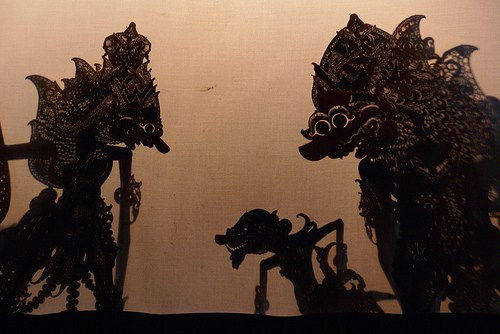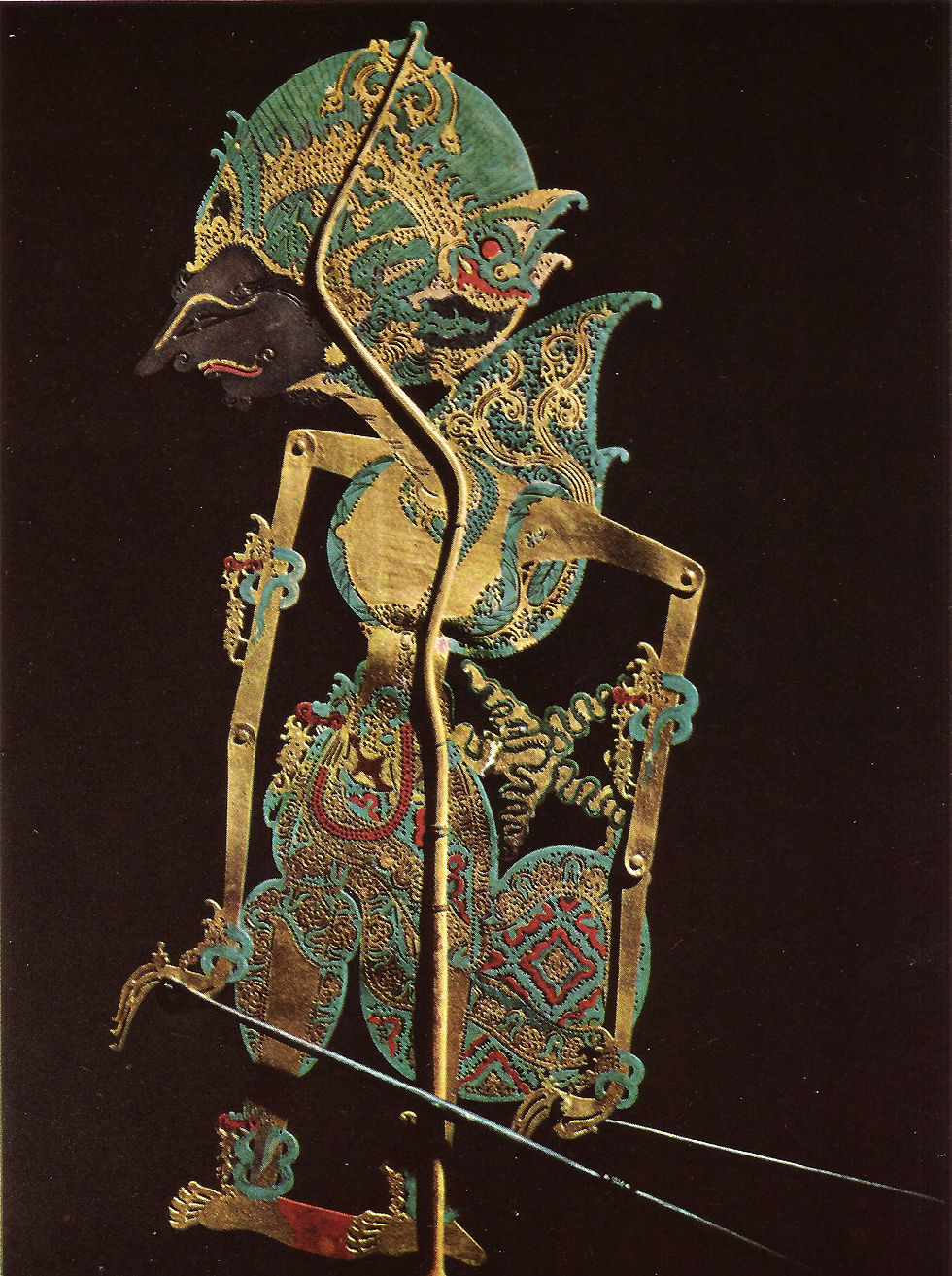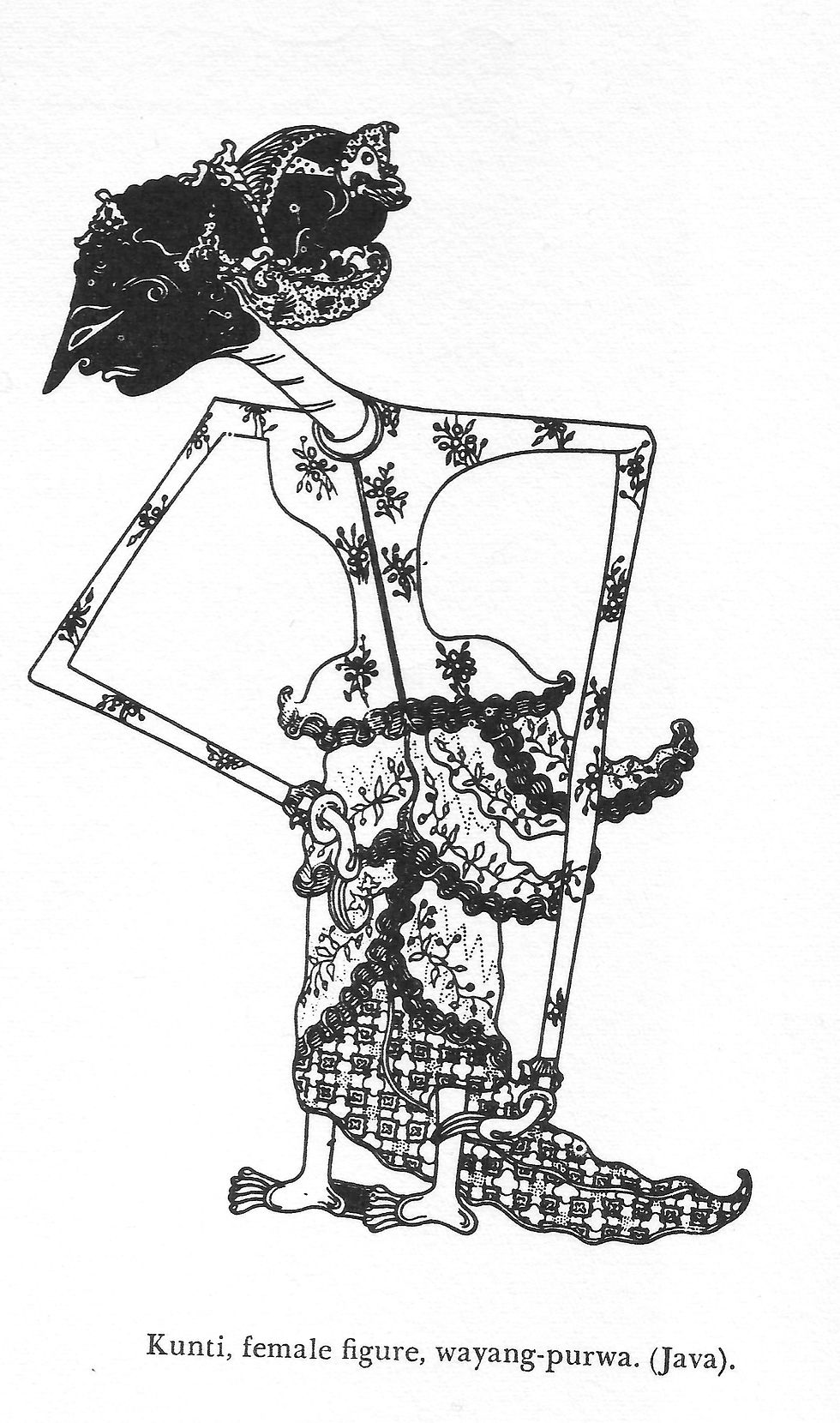In a dark theater, the glowing eyes of focused spectators study the silky screen of the Wayang-Kulit puppet tales. The dimly lit room presents a light illuminated canvas where the traditional stories of Javanese culture mixed with Islamic, Indian and Buddhist influences create a single expression of Indonesia. unique to the island people.
A sturdy and flat leather puppet becomes an illustration for existence in the spiritual and physical world; as their stenciled bodies cast shadows onto a screen, those shadows becoming a reality in front of the spectators. The stories are ancient but brought to life in each unique performance. The characters of each master-tailored puppet are elaborate and different, and the 30 odd characters are each possessed with a distinct voice throughout an entire session, and performed by a single man, the dalang. The combination of the two art forms, the skilled artwork of the puppets and the genuine dalang performance, is what breaths life into the show and the reality that it presents.

Wayang
It becomes so easy to loose yourself when watching a Wayang puppet show; the ornate and detailed stencil in the fine illustration of the vellum-cut puppets are mesmerizing as they dance and confront one-another on the screen. The stylized and accented faces, the profiles of heroes and demons that vary, are adorned with fractal-like apparel and head pieces that appear almost extraterrestrial.
Wayang, meaning shadow or ghost, and Kulit, Bahasa for leather or skin, Wayang-kulit is just one of several forms of this national art-form, and these leather-made puppets are the most iconic on the main island of Java. (Wagner, 128).
Wayang-purwa meaning the "oldest" or "first wayang", are the original Javanese literature, part of the Lakons. There are too many Lakons to mention, and while some take influence from other places, all are ultimately significant to Indonesian culture. These stories present time-less events of ancient of mystical meaning; They vary from stories of wars between gods and demons, of historical figures, and other religious tales, to the love story of Rama and Cita being arguably one of the most well-known.
These stories are presented in many types of performances as well as types of puppets and mediums. There are round wooden carved puppets called Wayang-golek, which share similar rotatable joints for the movement of the puppets' arms, which are attached to pisang stalks.(128-129) The movable limbs of the wayang-kulit and Wayang-golek enlivening the performances with motion and aid in body language. The same stories are also enacted in live outdoor plays (wayang-wong) as well as passed through oral traditions, and in written forms (Wayang-beber). (Wagner, 146-47).
Style
As a child growing up in Indonesia, I was exposed to these performances at school and with my family, and was influenced by the culture and style of the wayang as an artist, even even I may have not known the whole time. The faces of the characters were so expressive and intimidating, comical and charming. Their world, so developed and aware of itself, illustrated in its wild manifestations by the ornate details that compose of the artworks. The ideas they represent, so wholesome and universal, I am still awe-struck by their success as art to this day.
So unusual are the puppet's profile, with slanted eyes and and a forehead and nose that forms one straight line. The demons with their grotesque and bulging eyes are bizarre as they stare back at the viewer. The thin and unnatural anatomy of the arms and fingers bring a cartoonish quality that is matched by the humorous dialects of the characters made by the dalang, making them so memorable. (Wagner, 132).

The key role in Javanese wayang puppet-shows to continue these stories, but the way in which they are done is exceptional. The artistry involved is a balancing act of tradition, and part of that moment in time. To relate the mystical stories to real life problems is the dalang's biggest challenge.
The culture is infectious, the style of the art so traditional and organic, so utterly refined and loose. The stenciled patterns and overlaid paint are as ornate as any European painting, and the batik influenced patterns and forms are emphasized in the clothes of the puppets. The stenciled holes reveal space, giving the characters depth and liveliness when their shadows are exposed, and can grow in size on the sheet depending on the distance from the light source.

Years of repetition and practice produce gold adorned figures of master craftsmanship. To visit a workshop and witness the process of building these leather figures was humbling, but with it comes also a greater respect for the final piece as an living piece of art with a purpose.

The performance is accompanied by the traditional Gamelan Orchestra. The stylized art, expressive drama performance, and immersive musical atmosphere creates the reality of the Wayang theater, allowing the audience to loose touch with their selves and become immersed in the show.
Religious Tolerance
An interesting side note on the stylized representation of the Wayang -puppets, is in the historical changes of the the second millennia when Islam influenced Indonesian population. Islam was introduced to the islands through traders and ships, not through large institutions. The accepted culture of Wayang was already ingrained in the society, so when Islam, which prohibits representations of any figures, influenced the hearts of the Javanese, wayang was able to withhold presence. This religious tolerance was also found in the island of Bali, where the dominant Buddhist religion also adapts to the Wayang performances. (151)
Perhaps because of the mystical significance of the stories on society, and the use of the shadows and a channel of communications instead of direct representation, wayang was able to continue; and with that encouraged a continued tolerance for faiths in the community.
Light
Much of the Lakons involves a continuous fight between good and evil, and the balance between light and dark rests in the hands of mankind. A constant reminder for the people in the audience are the moral choices that they share with the puppets. The choices we make are ones that may lead or stray us from the spiritual Light; but that these morals are something universal to many religions and are projected into the Wayang.
The Wayang puppet shows do something more abstract with these concepts of the spiritual world, represented by light. The puppets literally obstruct the light from the viewers, in a way it is an analogy for the distractions of our day, the demons inside us that keep the good of man from the light.
Without a light, there is no shadow, we have no silhouette. Without the light, the reality of the Lakons and the Wayang-purwa are no longer tangible and cannot be witnessed. It must have been quite magical to watch a Wayang show before television had existed.
Puppetry
The Wayang puppet shows are providing a visual representation of the mystical and spiritual world, giving face to something we can only dream to witness. So then what do the puppets represent on the greater scale?
They are agents of the tales they are in; beings without bodies but who still have influence on through their story. But to be a puppet to to lack any control over your situation.

Puppets are scripted, they do not have free will.
They are put into a predicament as an analogy or a place-holder for a real individual. What does that say about the spectators who watch the puppets in their predicaments? The puppet is on its pisang stalks, but the audience surely has free choice unlike the puppet?
The alternate reality of the Wayang presents a new perspective for the viewer, outside the realm of spirituality that they are normally only in contact through with worship. Perhaps the Wayang-purwa teaches a new way of reflecting on our own determinism and morals, by reminding the viewers of their own position of restraint in the reality they live in.
Reality
The screen that displays the shadows, the space that holds these apparitions becomes a location outside the physics. The shadows of the puppets do not really exist, they are merely filters of light. But out of this shadow-world comes faith and life, familiar emotions, truth and understanding.
In a world where there are many realities within one reality, in the age of technology where there are many other forms of entertainment that cause similar suspensions of disbelief, what can the Wayang have to offer. Unfortunately it is not as popular to watch Wayang for many young Indonesians as it used to be. The youthful generations of Indonesia are growing up disinterested in their own culture and the heavy lessons they are liable to learn through the puppet shows. (Kasnowihardjo. 2012)
If there is one certainty, it is in the fact that the Wayang culture has made an undeniable effect on me, my art and my outlook of certain aspects of reality.
While not consciously at first, I have over time realized how much the Indonesian artwork and wayang-puppets that were displayed in my parents home had an influence on my stencils and collage technique. The fragmented and organically flowing patterns are a quality I have longed to bring into my artwork, and the intricate and steady details that appear so natural are clearly related to the steady craftsmanship I witnessed in Java.
I have always claimed that each place I lived helped to form a bit of my character. While cultural appropriation is something I aim to avoid, I find that by studying and researching other artistic cultures like this brings universal truths and themes that are more human than belonging to any one race or nation into the light. Those truths and themes are what strengthen my art as well as the artworks it responds to, and hopefully teach a bit more about the global cultural heritage that we all share.
References:
Kasnowihardjo, H. Gunadi. “Wayang Purwa: within a Study of Archaeology, Art and Identity of a Nation”, Paper presented with Balai Arkeologi Yogyakarta ,2012. Translated by Diane Butler.
Wagner, Fritz A. Indonesia: The Art of an Island Group. New York: Greystone Press, 1967. Print.
Image Reference:
p. 115. Wayang Purwa figure representing Bupati Karma, Prince of Wangga, half brother of Adjuna. (Java)K.I.T.
p.145. Wayang-purwa:group of Panankavans (Java).
p.133. Kunti, female figure, wayang-purwa. (Java).
